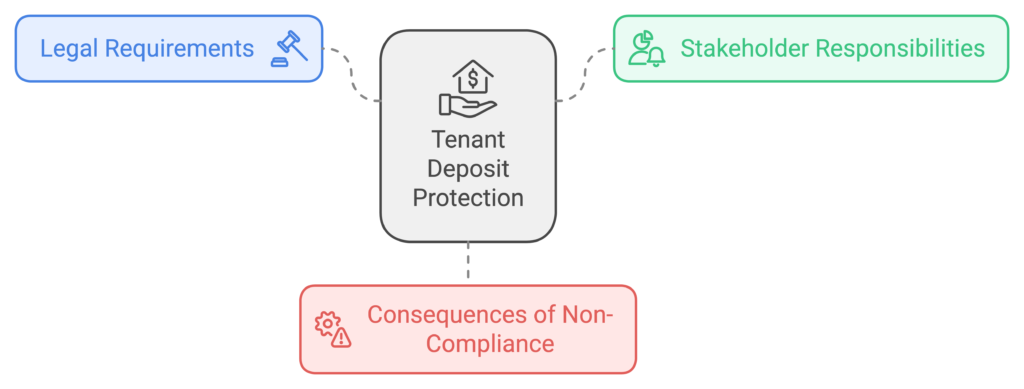Since 6 April 2007, tenancy deposit protection (TDP) schemes are a must for landlords. It’s key for them to know their duties and the deposit protection choices they have.
Tenant deposits are crucial in the lettings world. They protect both landlords and tenants. These schemes, backed by the government, ensure tenants get their deposits back if they follow their tenancy agreement. They also need to avoid damaging the property and pay rent and bills on time. Landlords can use the deposit to cover any losses or damages during the tenancy.
Key Takeaways
- Tenancy deposit protection is mandatory for UK landlords renting properties on assured shorthold tenancies started after 6 April 2007.
- Deposits are capped at five weeks’ rent for properties with annual rent below £50,000, and six weeks’ rent for those above £50,000.
- Landlords must protect deposits within 30 days of receipt using one of the three approved schemes in England and Wales: Deposit Protection Service, MyDeposits, or Tenancy Deposit Scheme.
- Scotland and Northern Ireland have separate TDP schemes, with SafeDeposits Scotland Ltd and TDS Northern Ireland Ltd being the largest providers respectively.
- Landlords can choose between custodial (free) or insured schemes, each with their own benefits and administrative requirements.
Understanding Tenant Deposit Protection Requirements
In the UK, landlords must protect their tenants’ deposits since 2007. This rule applies to most private rental properties. They need to protect the deposit, usually 4 to 6 weeks’ rent, within 30 days.
Legal Framework and Compliance Timeline
Landlords have a tight deadline to protect the deposit. They must do this within 30 days and tell the tenant about it. If they fail, they could face big penalties, including paying up to three times the deposit amount.
Key Stakeholder Responsibilities
Landlords, tenants, and deposit schemes all play important roles. Landlords must protect the deposit and inform tenants. Tenants can challenge any deductions from their deposit. The deposit schemes help resolve these disputes.
Protection Deadlines and Penalties
Landlords who miss the 30-day deadline face serious consequences. Tenants can claim up to three times the deposit value. Landlords might also struggle to evict tenants until the deposit is protected. It’s crucial for landlords to meet these deadlines to avoid legal trouble.

Types of Deposit Protection Schemes in the UK
In the UK, there are two main types of deposit protection schemes: custodial and insured. Custodial schemes keep the deposit for free. Insured schemes let landlords or agents keep the deposit and pay for insurance.
The Deposit Protection Service (DPS) and Tenancy Deposit Scheme (TDS) offer custodial schemes in England and Wales. Scotland only uses custodial deposit protection schemes.
Choosing between custodial and insured schemes depends on the landlord’s preference. Some like custodial schemes because they don’t cost anything upfront and are easy to use. Others prefer insured schemes to keep control over the funds and any interest they might earn.
| Scheme Type | Description | Availability |
|---|---|---|
| Custodial Schemes | The deposit is held by the scheme provider at no cost to the landlord. | Available in England, Wales, and Scotland |
| Insured Schemes | The landlord or agent holds the deposit in their own account and pays a protection fee. | Available in England and Wales |
Landlords must protect their tenants’ deposits within 30 days of receiving them. This is to follow the law and avoid penalties.

Custodial vs Insured Schemes: Making the Right Choice
In the UK, landlords have two main choices for protecting tenant deposits: custodial and insured schemes. Each has its own benefits. The right choice depends on the landlord’s needs, budget, and the size of their property portfolio.
Benefits of Custodial Schemes
Custodial schemes, like the Tenancy Deposit Scheme (TDS) Custodial, are popular for their ease and no upfront costs. Landlords give the deposit to a government-approved provider. This provider handles the protection and any disputes, making it ideal for those with smaller portfolios or who prefer less hassle.
Advantages of Insured Schemes
Insured schemes, such as the TDS Insured, let landlords keep the deposit funds while still meeting legal standards. This is great for those who want to earn interest or be more involved in disputes. Insured schemes charge a small fee but offer perks like rewards for low dispute rates.
Cost Comparison and Administrative Requirements
The decision between custodial and insured schemes depends on the landlord’s financial and administrative needs. Custodial schemes are free, but insured schemes charge a fee. Insured schemes require more effort, like handling returns and disputes. Landlords with big portfolios or who want control might choose insured. Those looking for simplicity might prefer custodial.
Step-by-Step Guide to Registering Deposits
In the UK, landlords must protect their tenants’ security deposits. First, they need to figure out the right deposit amount. This amount should not be more than five weeks’ rent for properties with an annual rent under £50,000. For higher rents, it’s six weeks.
After the tenancy agreement is signed and the deposit is paid, landlords have 30 days to register it. They must use a government-approved scheme.
To register, landlords need to give out information about the tenant, the property, and the deposit. They also need to tell their tenants about the deposit protection scheme. This includes the scheme’s details and how to solve any disputes.
- Three government-approved Tenancy Deposit Protection schemes in the UK: Deposit Protection Service (DPS), MyDeposits, and Tenancy Deposit Scheme (TDS).
- Landlords legally obligated to protect the security deposit within 30 days of receiving it.
- Security deposit typically calculated as a multiple of the monthly rent, ranging from one to two months’ rent.
Keeping good records is key. Landlords must keep proof of protection, communication logs, receipts, and reports from check-ins and check-outs. This helps in case of a dispute over the deposit.
By following this guide, landlords can meet their legal duties. They also ensure their tenants are protected and informed. It’s wise to stay updated on laws and seek advice, especially for new landlords.
Deposit Protection Schemes: UK Landlords Guide
Essential Documentation Requirements
In the UK, landlords must have the right documents for deposit protection schemes. These include the tenancy agreement, proof of deposit receipt, and details of the chosen scheme. These documents are key to following the law and being clear with both landlords and tenants.
Registration Process Overview
The process to register for deposit protection schemes has several steps. First, landlords must pick a government-approved scheme, like the Deposit Protection Service, MyDeposits, or the Tenancy Deposit Scheme. Then, they need to give the scheme the tenant’s details and the deposit amount. Lastly, the deposit must be secured within 30 days of getting it from the tenant.
Compliance Checklist
- Calculate the correct deposit amount, following the Tenant Fees Act 2019.
- Choose a government-approved deposit protection scheme to protect the tenant’s deposit.
- Register the deposit with the chosen scheme within 30 days of getting it from the tenant.
- Give the tenant the necessary information about the deposit protection, including the scheme details and their rights.
- Keep detailed records of all deposit-related transactions and communications during the tenancy.
By following this checklist, UK landlords can meet their legal duties and protect their tenants’ deposits.
| Deposit Protection Scheme | Key Features | Landlord Responsibilities |
|---|---|---|
| Deposit Protection Service (DPS) |
|
|
| MyDeposits |
|
|
| Tenancy Deposit Scheme (TDS) |
|
|
Understanding the documents needed, the registration process, and the compliance checklist helps UK landlords manage deposit protection schemes well. This ensures they meet their legal duties to protect their tenants’ deposits.
Managing Deposit Disputes and Resolution Processes
Deposit protection is key in the landlord-tenant relationship. But, disputes can happen at the end of a tenancy. If a landlord wants to deduct from the tenant’s deposit, they must tell the tenant why.
If the tenant disagrees with the deductions, they can challenge them with the deposit protection scheme. The scheme will then start a fair dispute resolution process.
In this process, both sides will send in evidence to back their claims. An impartial judge will look at this evidence and decide how the deposit should be handled.
To win a deposit dispute, landlords need to keep good records. This includes detailed inventory checks and clear talks with tenants. These records are crucial evidence in the dispute resolution.
| Deposit Dispute Resolution Timeline | Timeframe |
|---|---|
| Landlord and tenant submit evidence | 14 calendar days |
| Adjudicator reviews evidence and makes decision | Up to 28 calendar days |
| Total dispute resolution process duration | Up to 51 calendar days |
| Time for any payments to be completed after decision | 3-5 working days |
The dispute resolution process can take longer if there are issues with the evidence or claim. It’s vital for landlords and tenants to know the rules of their deposit protection scheme. This helps in resolving disputes smoothly and quickly.
Prescribed Information Requirements and Deadlines
UK landlords must give tenants key details about their deposit. This includes the protection scheme, deposit amount, and property address. It also covers the landlord and tenant’s information, reasons for any deductions, and how to resolve disputes. This must be done within 30 days of getting the deposit.
Required Documentation
The information landlords need to share with tenants includes:
- The name, address, and contact details of the deposit protection scheme administrator
- An information leaflet about the scheme
- Procedures for disputing or obtaining the return of the deposit
- Specific details of the deposit and tenancy, such as the deposit amount and the property address
- Circumstances under which the deposit, or any part of it, may be retained by the landlord
- A signed certificate of accuracy for the information provided
Serving Timeframes
Landlords must give this information to tenants and others within 30 working days of getting the deposit. Not doing so can lead to fines and restrictions on Section 21 notices.
Legal Implications
Landlords should keep proof of giving the prescribed information to tenants. A UK Landlord Survey found 60% of landlords struggle with deposit disputes. Giving the right documents on time can avoid legal problems and follow deposit protection laws.
End of Tenancy Procedures and Deposit Returns
As a landlord, you have key duties at the end of a tenancy. The UK’s deposit protection laws say you must return the deposit within 10 days. This rule applies whether the deposit is in a custodial or insured scheme.
If there’s no disagreement, you should give back the full deposit. But, if you want to deduct something, you need proof and the tenant’s okay. For custodial schemes, tell the scheme to release the deposit. For insured schemes, you give it back to the tenant yourself.
If there’s a dispute, the deposit stays protected until sorted out. Do a detailed check-out and note any issues that might mean deductions. This evidence is key when resolving disputes.
Landlords must know the law and best practices for deposit returns. This ensures a smooth end-of-tenancy and keeps tenant relations good. By following the right steps and providing clear evidence, you protect yourself and your tenant’s rights.
Common Mistakes to Avoid in Deposit Protection
Managing tenant deposits can be tricky for landlords. They must follow many legal rules and deadlines. Knowing the common mistakes helps landlords stay on the right path and avoid problems.
Documentation Errors
Landlords often make mistakes with tenancy agreements and inventory reports. These errors can cause issues when it’s time to deduct from the deposit. It’s important to have all the right documents, like the tenancy agreement and property condition reports. These should show the property’s state at the start and end of the tenancy.
Timeline Violations
Landlords in the UK must protect a tenant’s deposit within 30 days. They also need to give the tenant important information during this time. If they miss this deadline, they could face big fines and not be able to evict the tenant legally. It’s vital to keep track of these deadlines to avoid trouble.
Communication Failures
Good communication with tenants is key, especially about deposit deductions. If landlords don’t explain deductions clearly or don’t answer tenant questions quickly, disputes can arise. Keeping the lines of communication open helps avoid misunderstandings and solves problems peacefully.
By avoiding these common mistakes, landlords can protect themselves and their tenants. They should use strong deposit protection systems, keep detailed records, and communicate well. This way, they can handle deposit management and follow the law smoothly.
| Deposit Protection Scheme | Key Features | Cost |
|---|---|---|
| Deposit Protection Service (DPS) | Custodial scheme, holds deposits for free | Free |
| MyDeposits | Insured scheme, landlord insures deposit value | £15 – £30 per deposit |
| Tenancy Deposit Scheme (TDS) | Custodial and insured options available | Custodial: Free, Insured: £15 – £30 per deposit |
Changes in Deposit Protection Legislation
Deposit protection laws in the UK have changed a lot since 2007. The Tenant Fees Act 2019 capped deposit amounts at five or six weeks’ rent. This depends on the annual rent value.
The Act also banned most fees for tenants. In Scotland, deposits are capped at two months’ rent. Landlords must keep up with these changes to avoid big penalties.
Recent laws have mainly aimed to help tenants and make solving disputes easier. Future updates might make deposit protection and dispute handling even better. This will help ensure fairness for both landlords and tenants.
- Deposit protection laws have evolved since 2007, with key changes including the cap on deposit amounts and the banning of most letting fees charged to tenants.
- Landlords must stay informed about legislative changes, as non-compliance can lead to severe penalties.
- Recent updates have focused on improving tenant rights and streamlining dispute resolution processes, and future changes may further refine deposit protection requirements and dispute handling procedures.
It’s vital for property professionals to keep up with deposit protection legislation, landlord responsibilities, and tenancy agreements. This ensures they comply and offer the best service to their tenants.
Best Practices for Deposit Management
Managing deposits well is key for landlords in the UK. It helps them follow the law and keep good relations with tenants. Knowing the best ways to handle deposits can prevent problems and avoid fines.
First, landlords must get the deposit amount right. The Tenant Fees Act sets the legal limits. In England, the maximum deposit is five weeks’ rent for properties earning less than £50,000 a year. For properties earning more, it’s six weeks’ rent.
After getting the deposit, landlords must protect it within 30 days. They can use a custodial scheme or an insured scheme. The custodial scheme holds the deposit, while the insured scheme lets the landlord keep it but requires insurance.
It’s wise to do detailed inventories and check the property at the start and end of the tenancy. Landlords should take photos and keep records of all deposit-related activities.
- Regularly check the property to spot and fix problems early.
- Know how to handle disputes with your chosen deposit protection scheme. Be ready to prove any deductions you make.
- Keep in touch with your tenants. Give them receipts for any work done and answer their questions quickly.
By sticking to these practices, landlords can manage deposits well. They’ll meet legal standards and keep their tenants happy.
| Best Practice | Description |
|---|---|
| Accurate Deposit Calculation | Follow the legal limits for deposit amounts set by the Tenant Fees Act. |
| Timely Deposit Protection | Protect the deposit with an approved scheme within 30 days of receiving it. |
| Thorough Documentation | Do detailed inventories and inspections, and keep all records. |
| Proactive Communication | Communicate clearly and promptly with your tenants, answering their questions. |
By following these best practices, landlords can manage deposits effectively. They’ll meet legal requirements and build strong relationships with their tenants.
Conclusion
Deposit protection is key in the UK’s property letting world. It keeps tenant money safe and ensures fairness for landlords and tenants. It’s a must-follow rule, with big legal and money penalties for those who don’t.
Landlords need to pick the right deposit protection schemes. They must follow strict rules and keep everything clear and documented. This is crucial for a good tenancy experience.
By following the best practices and keeping up with law changes, landlords can handle tenant deposits well. This helps avoid problems and makes the tenancy smooth for everyone. The Renters’ Rights Bill in 2025 will make things even clearer for landlord responsibilities in England.
Deposit protection schemes in the UK offer a solid way to protect tenant deposits. They have custodial and insured options for different landlords. With many providers and prices, landlords can find the best fit for their needs and follow the law.




